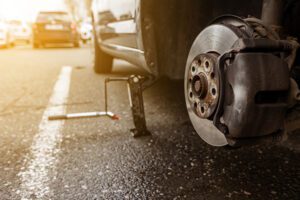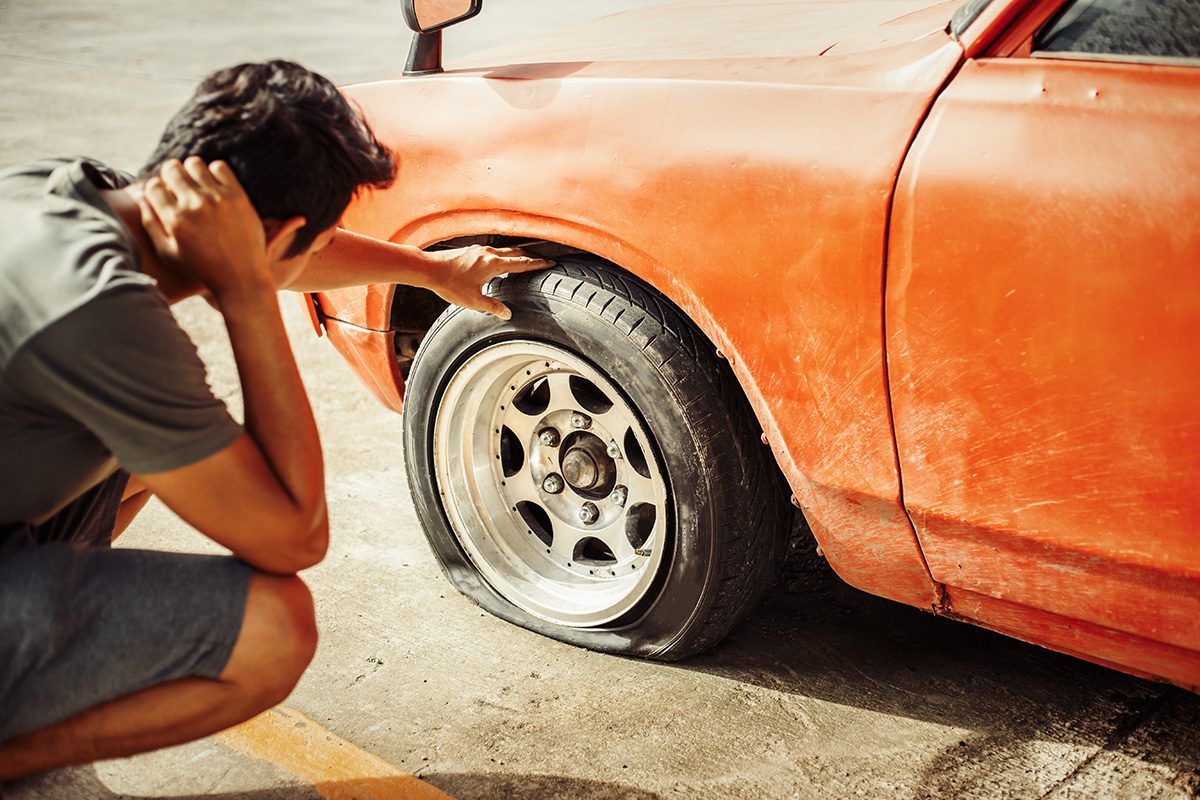Need Flat Tire Repair? 5 Steps to Take When You Get a Flat
Whether you hear that dreaded “thud, thud, thud” while driving or go out to your car in the morning to find it leaning slightly to one side, a flat tire is always inconvenient. It can leave you feeling frustrated or even angry that your day is now delayed because you must deal with this problem. You just want to get your tire fixed quickly so that you can get to your destination.
We understand how annoying it is to deal with a flat tire and that you may also worry about the cost of tire repair or replacement. That’s why at Dutch Valley Auto, our tire shop makes it easy to fix a flat tire—whether that’s through a plug or patch for the tire or getting a new tire completely because the old one is too deteriorated. Plus, we offer these services at affordable prices so that you never have to stress out about a flat tire again!
Reasons for Flat Tires

Flat tires can occur for several reasons, and the cause of your flat tire will determine whether you can take it to a service center for tire repair or if you’ll need a replacement tire instead. Some common reasons for flat tires include:
- Puncture or damage
- Tire failure
- Damage to the valve stem system
- Excessive wear and tear
- Separation of the tire and rim
- Blow out from over or under-inflation of the tire
No matter what reason you have a flat tire, a quality tire shop, like Dutch Valley Auto, can evaluate your tire’s condition and make appropriate recommendations for you to get it fixed.
How Can I Tell if My Tire is Flat?
If you’ve never had a flat tire before and there’s no obvious sign—like a loud noise when you drive or a visibly deflated tire, there are other ways to tell if your tire is flat. For example, your vehicle may be equipped with a tire pressure monitoring system. When your tire has low air pressure, it will display a warning sign on your dashboard for you to add air to the tire. Other symptoms that you have a tire problem include:
- Difficulty accelerating
- A dragging feeling on one side of the car
- A popping or leaking sound
- Inaccurate handling when changing lanes, turning, or going around a curve
5 Things to Do When a Flat Tire Occurs
You have a few options when you notice you have a flat tire. The first option is to remove the flat tire and put on a spare tire. Since you can only drive on spare tires for no more than 70 miles, you’ll need to head to a tire shop to either get tire repair or replacement, depending on the issue.
You can also try fixing the tire yourself with something like Fix-a-Flat, but you’ll still have to get a flat tire repair sooner than later. We recommend following these steps when you get a flat tire:
1. Pull Over Safely
If you’re driving and notice a flat tire, pull over as soon as it is safe. It is not a good idea to drive with a flat tire, as it could make the situation worse and even damage your rims. Try to get to level ground to make it easier to change the tire. Turn on your hazard lights and set reflectors on the road to warn oncoming motorists that you are there.
2. Check the Damage
Next, check your tires to see which one is flat or losing air. If it’s just one tire, you can put on a spare, drive to get tire repair services for a permanent fix of a small puncture, or purchase a new tire for more extensive damage.
You may also want to check if you have the tools necessary to change a tire, which includes, at minimum, a jack, lug wrench, and a spare tire (some newer cars don’t come with a spare, so it’s a good idea to check). If more than one tire is flat, you’ll likely have to call for a tow since you probably don’t have two spare tires in your car.
3. Remain Safe
Throughout this entire process, you’ll want to be sure you remain safe. Pulling over to the side of the road and putting on your hazard lights is the start, but if you are in an area where you feel unsafe, you don’t have a spare tire or the required tools, or it’s dark out, you may want to call for help.
Many auto insurance companies now offer roadside assistance for these situations. Call to see if yours does and the cost (if any). Otherwise, you can proceed with changing to the spare tire.
4. Use the Spare Tire

Changing a tire seems like a daunting task, but it’s not that difficult. If you’ve never changed a tire or it’s been a few years, here are the basic steps to get your spare on your vehicle:
- Check the condition of the spare tire. Ensure it’s not flat or dry-rotted, and check that it’s safe to use.
- Gather your tools and bring them over to the tire that needs to be changed. Remove the hub cap if you have one, and use the lug wrench to loosen the lug nuts. Loosen the nuts enough that you can turn them by hand, but don’t remove them entirely just yet.
- Use the jack to lift your car. Be sure to put it under the metal portion of the frame and not the plastic parts.
- Finish removing the lug nuts completely and keep them in a safe place.
- Remove the flat tire by firmly gripping it with both hands and pulling it towards you.
- Put the spare tire on by lining up the holes with the lug nut posts. Push the extra tire as far as you can onto the wheelbase.
- Place the lug nuts back on and tighten them with your hand slightly to help keep the tire even.
- Use the jack to lower the vehicle until your tire starts touching the ground.
- Tighten the lug nuts with the wrench in increments to keep the tire straight, alternating every other nut. Repeat the tightening process in this order until the lug nuts are equally tight. For example, if you number the lug nuts starting at the top, tighten nuts in this order: 1, 3, 5, 2, 4. Some people find it helpful to pretend to draw a star while tightening the lug nuts to ensure they are tightening them in the correct order.
- Finish lowering your car to the ground and recheck your lug nuts. You may be able to tighten them further, and you should do so until they no longer budge.
5. Bring Your Vehicle to a Tire Repair Shop
Once your spare tire is securely on your vehicle, pick up all your tools and secure them in your car. Drive to a tire repair shop, like Dutch Valley Auto, to have your flat tire inspected and repaired if possible. We’ll check your tire sidewall, tread depth, size, and damage to make sure that you remain secure when driving your vehicle. We follow all manufacturer recommendations and industry standards to ensure that your tires are safe to use.
Need Flat Tire Repair? Schedule Your Service Appointment Now!
Even if you take precautions to prevent flat tires, such as regular tire rotations, appropriate maintenance, and other car care services, a flat tire can still happen. When it does, you need a tire repair shop you can trust to provide the tire services you need to get back on the road quickly.
Since 1971, your friends, neighbors, and colleagues in Lancaster, PA, have brought their vehicles to us for repair services, and we can help you too! Simply request an appointment online or give us a call to schedule your tire services now! At Dutch Valley Auto, we are experts at auto and tire repair, so you can trust us when you get a flat tire.




